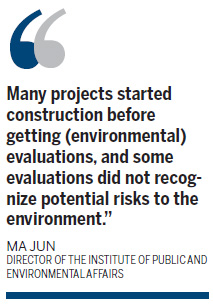Economy
Brakes slammed on railways
By Xin Dingding (China Daily)
Updated: 2011-05-19 13:09
 |
Large Medium Small |

BEIJING - The country's environment watchdog has ordered the operation of one high-speed railway to stop and halted construction on a second over violations of environmental laws.
The Ministry of Environmental Protection posted a notice on its website on Wednesday ordering the construction of the line between Tianjin municipality and Qinhuangdao, Hebei province, to stop because the project had not applied for an environmental re-evaluation after changing some of the locations.
Before this, the ministry issued a notice on April 25 asking the Jiaoji passenger railway between Qingdao and Jinan, East China's Shandong province, to stop operation because the line had not yet passed an environmental evaluation.
A report by the Guangzhou-based newspaper 21st Century Business Herald, citing insiders, says the railway, one of the country's first high-speed railways, was permitted by the National Development and Reform Commission in 2006 to apply for an environmental evaluation after the line was completed. But it had to pass the evaluation before opening to traffic.
However, the line, which has operated bullet trains since it was completed in 2008, has not filed an application. The railway company argued it had taken measures to avoid a negative impact on the environment and, if the line stops operation, it would cause huge economic and social losses.
A publicity official with the Ministry of Railways declined to comment on the two incidents on Wednesday.
Zhao Jian, a transport professor at Beijing Jiaotong University, said he had not heard of similar cases.
"The environmental authorities have always given a green light to railway projects," he said.
The issuing of the two notices coincides with tremors inside the Ministry of Railways.
Former railway minister Liu Zhijun, who advocated "leapfrog development", was removed from his post and became the subject of an investigation for alleged "severe violation of discipline" on Feb 12.
Sheng Guangzu, who replaced Liu, ordered the operating speed of high-speed railways lowered from 350 kilometers an hour to 300 km/h. He also ordered some projects cut, while giving priority to ongoing projects and those in urgent demand because of economic development.
Ma Jun, director of the Institute of Public and Environmental Affairs, a non-governmental organization, believed the notices "will help make the pace and scale of high-speed railway construction more rational".
Moreover, it is a gesture that the environment authority is trying to make evaluations play a bigger role by becoming more transparent and involving the public, he said.
"Though China introduced the environmental evaluation system three decades ago, the system has not been as effective as in Western countries. Many projects started construction before getting evaluations, and some evaluations did not recognize potential risks to the environment," he said.
The reason lies in how the evaluation is conducted.
In the West, an environmental evaluation is a process where different interest groups speak out and reach a consensus.
But in China, it is a technical process - a group of experts make observations and calculations. The result is likely to be affected by interest groups such as local governments who pursue economic development and developers who seek the most profits, he explained.
"It will take a long time before the evaluations can really do their work," he said.
| 分享按鈕 |



